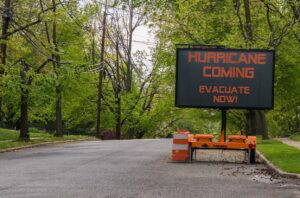There are tornado warnings, thunderstorm warnings, and excessive heat warnings. Unfortunately, there isn’t a derecho warning quite yet, but a derecho is another way Mother Nature unleashes her fury.
Before you can protect your family and home from a derecho, it’s important to know what you’re up against.
What is a derecho storm?
Short answer: A derecho is a violent windstorm that accompanies a line of thunderstorms and crosses a great distance.
Long(er) answer: A derecho is a line of straight-lined-wind storms that accompany fast-moving severe thunderstorms. To earn the coveted title of “derecho,” these storms must travel more than 250 miles, produce sustained winds of at least 58 mph along the line of storms, and create gusts up to 75 mph.
Derechos generally occur during the summer months and spawn additional extreme weather events, such as tornadoes, heavy rain, hail, and strong winds. Many thunderstorms accompanying a derecho form bow echoes and squall lines.
Derechos sound serious, so why isn’t there a derecho warning?

The storm system needs to travel more than 250 miles before it can be classified as a derecho. If not, it’s just a super strong set of thunderstorms.
But why are they so dangerous if they are just thunderstorms?

Derechos are so quick that they usually come with very little warning, especially during the developmental stages. They also generate hurricane-force wind gusts. Cedar Rapids saw wind gusts of 120 mph during last week’s derecho, and the June 2020 Pennsylvania-New Jersey Derecho produced gusts close to 100 mph.
Derechos also produce hail. The June 2017 Northern Plains Derecho created hen-egg-sized hail, and the 2018 Northeast Derecho dropped life-threatening hail on New York City. Ouch!
Should you worry about derechos?

As much as you worry about thunderstorms, tornadoes, hurricanes, etc. Many derechos leave massive damage in their wake, including extensive power outages, fallen trees, crumbling homes, and wide-spread flooding.
The June 2012 North American Derecho left millions without power after raging from Indiana to New Jersey. The Great Lakes Serial Derecho of June 2020 produced seven tornadoes, and the 2015 Midwest Derecho downed hundreds of trees in a national recreation area in Minnesota.
How can you protect your home and family from derecho damage?

If you live in an area where derechos happen often, such as Kansas, Oklahoma, Missouri, and Arkansas, you also see tornados and have probably taken many of the necessary derecho precautions already. However, for people who live in areas that see derechos every few years, then you should complete the following tasks.
- Stay away from windows and plugged-in electrical devices.
- Prepare for a power outage. Have your emergency kit ready with water and non-perishable food.
- If time allows, bring in anything outside that can damage your property or neighbor’s property. This can include grills, patio furniture, any sports or lawn equipment, and even your garden hose.
- Receive updates about the storm, and if you receive a tornado warning, head to the lowest level of your home and protect your head and neck.
- Trim branches around your home and take down any trees that are damaged or unhealthy.
- Observe your power lines. If a tree threatens them, call a professional to remove the branches.
- Identify a safe place in your home – on the lowest level, away from windows, where you can stay during the storm. If you live in a mobile home, identify a sturdy building you can go in case of emergency.
- Keep your emergency kit up to date.
- Move any heavy objects off high shelves, and install brackets on your top-heavy bookcases.
- Locate your shut-off valves for water and gas, as well as your main breaker, in case you need to cut the power.
- Know what needs to be tied down or moved inside from your yard or patio.
If you need any help with these projects, a reliable handyman can help you to complete some of these tasks.
Once a severe thunderstorm warning has been issued –

Be aware of your surroundings to avoid injury, especially if you’re outside. NOAA‘s storm prediction center usually provides warnings for thunderstorms or other dangerous weather events, though lead times may be short when a derecho is developing.
If you are outside, head inside for shelter and start taking precautions similar to those for severe thunderstorms:
- Stay away from windows and plugged-in electrical devices.
- Prepare for a power outage. Have your emergency kit ready with water and non-perishable food.
- If time allows, bring in anything outside that can damage your property or neighbor’s property. This can include grills, patio furniture, any sports or lawn equipment, and even your garden hose.
- Receive updates about the storm, and if you receive a tornado warning, head to the lowest level of your home and protect your head and neck.
Even though a derecho may be quick, the damage is generally widespread and the aftereffects can linger for months or even years.
Stay safe during extreme weather
Homeownership can be hard, but it doesn’t have to be. The vipHome.app can help. In less than four minutes, enjoy a new way to manage your home. Simply download the app, register your home, and be prepared for all Mother Nature can throw at you.






